
The Ristone Holdings agricultural group is completing the harvest on an area of about 38,000 hectares and is simultaneously finishing sowing winter crops, for which it has allocated 26,800 hectares, the agricultural holding’s press service reported on Facebook.
“Sunflowers were the main crop of this year’s harvest. As planned in the spring, 29,000 hectares were sown with this strategically important and highly profitable crop. As of today, the sunflower harvest from these areas has been completely completed,” the agricultural group stated.
In addition, the holding’s farmers harvested 5.5 thousand hectares of corn and 350 hectares of soybeans, thus completing the 2025 harvesting campaign.
In parallel with the harvest, Ristone Holding farms prepared the soil for the 2026 sowing campaign. The fields were plowed for winter crops, which is a key agronomic measure for moisture accumulation, soil structure improvement, and weed and pest control. The final stage of the autumn work was the sowing of winter crops, which is currently in its final stages.
For the 2026 harvest, the agricultural holding sowed 23,000 hectares with winter wheat and 3,800 hectares with winter rapeseed.
The Ristone Holdings group of companies is a vertically integrated agricultural holding company, which includes: Dnipromlyn LLC, Bakery No. 10 LLC, Orilsky United Elevator LLC, Agrofirma Orilskaya LLC, Agroalliance LLC, Agrofirma Victoria State Enterprise, Agrofirma im. Gorkogo LLC, Zlagoda Agricultural Production Cooperative, etc.
Ristone Holdings cultivates 65,800 hectares in the Dnipropetrovsk, Kharkiv, and Zaporizhzhia regions. It is engaged in the cultivation of grain and industrial crops, animal husbandry, production, and wholesale and retail trade in agricultural products, including flour, bread, bakery products, etc.
The founder and chairman of the supervisory board of Ristone Holdings is Vadym Nesterenko.
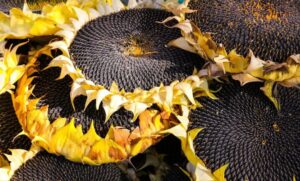
The IMC agricultural holding has completed the sunflower harvest from an area of 24.8 thousand hectares and collected over 81 thousand tons with a record yield of 3.3 t/ha, the agricultural holding’s press service reported on Facebook.
IMK cited data from the Ministry of Economy, Environment, and Agriculture, according to which, as of October 6, 2025, the average sunflower yield in Ukraine was 1.83 tons/ha.
“The sunflower harvest was not easy — the weather this year made its adjustments more than once. We exceeded the planned yield indicators, the average oil content reached a record 54%, and in some fields it reached an incredible 64%,” said IMC Chief Operating Officer Bohdan Kryvitsky.
IMK also completed the sowing of winter wheat for the 2026 harvest on an area of 21,000 hectares, which is 18% of the company’s total land bank.
“This year, due to problems with autopilot systems caused by the operation of electronic warfare equipment, we were forced to return to sowing with physical markers. Despite this, we worked in an organized manner and met the optimal deadlines,” Kryvitsky commented.
IMK Agroholding is an integrated group of companies operating in the Sumy, Poltava, and Chernihiv regions (northern and central Ukraine) in the segments of crop production, elevators, and warehouses. The land bank is 116,000 hectares, storage capacity is 554,000 tons, and the 2024 harvest is 864,000 tons.
IMK ended 2024 with a net profit of $54.54 million, compared to a net loss of $21.03 million in 2023. Revenue grew by 52% to $211.29 million, gross profit quadrupled to $109.10 million, and normalized EBITDA increased 25-fold to $86.11 million.
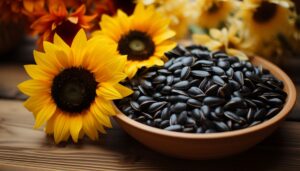
Ukrainian farmers expanded their sunflower production area by 3.3% in the 2025-2026 marketing year (MY) compared to the 2024-2025 MY, given its attractive prices in the past poor harvest year, and the harvest will be 3% higher, according to forecasts by the industry analytical agency UkrAgroConsult.
The agency expects that the sunflower harvest forecast for 2025/26 MY will be 3% higher than last year, given that the sunflower market is the “grayest” among other oilseeds.
“Currently, harvest statistics show low yields. Expectations that the northward and westward progress of the harvest will significantly increase yields have not been confirmed. Yields are increasing but remain quite low,” experts explained.
They recalled that in 2024/25 MY, the sunflower harvest was 20% lower than in 2023/24 MY and at the same time became the lowest since 2016/17 MY. At the same time, the sown area was reduced by 2%, and the yield by 18%.
The share of domestic processing of the harvest in 2024/25 MY remained high at 97% due to the cessation of active outflow of raw materials for export, while sunflower oil exports became minimal since 2026/17 MY (-24% compared to 2023/24 MY). Almost the entire season was marked by farmers’ restraint in selling sunflower seeds. Accordingly, sunflower meal exports were also minimal over the last three seasons (-27% compared to 2023/24 MY).
“In general, the 2024/25 marketing year can be characterized as a crisis, which led to a balance between limited resources and the desire to maintain Ukraine’s position in the global market for sunflower processing products,” UkrAgroConsult stated.
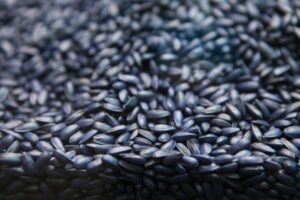
Sunflower processing in Argentina in August 2025 increased to 488 thousand tons compared to 330 thousand tons in the same month of 2024, according to the APK-Inform agency, citing data from Oil World. At the same time, the figure was only slightly lower than in July of this year (491,000 tons).
According to experts, processing in September and October will continue to significantly exceed last year’s figures, as Argentine processors are taking advantage of the decline in sunflower harvests in Ukraine, Russia, Turkey, and Bulgaria.
Argentine sunflower oil is currently the most competitive on the world market and is sold at significant discounts compared to products from the Black Sea region. Thus, exports in August amounted to 172,000 tons, compared to 116,000 tons a year earlier. The main destinations are India (90,000 tons compared to 21,000 tons a year earlier) and Iraq (14,000 tons compared to 31,000 tons).
According to data from the Argentine Ministry of Agriculture, the sunflower harvest in 2025 exceeded forecasts and amounted to 5.3 million tons, compared to 3.9 million tons in 2024. The country’s authorities expect to maintain high production levels in 2026 by increasing the area under cultivation by 10% annually.
Analysts at the Experts Club note that the growth in processing and exports from Argentina is putting pressure on the global sunflower oil market, lowering prices and increasing competition.
For Ukraine, one of the world’s largest producers and exporters of oil, this could mean a reduction in export revenues and the need to actively seek new markets, as well as to focus on deeper processing and improving product quality.
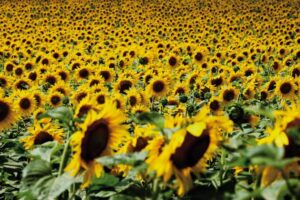
Consulting agency UkrAgroConsult forecasts a 5.7% decline in sunflower harvest in the 2025 season to 13.3 million tons from 14.1 million tons in the previous forecast due to drought in southern and eastern Ukraine, the agency’s press service reported.
“Crop losses are mainly observed in the southern and eastern regions, where drought has significantly affected crops. In contrast, the situation is more favorable in the northern and western regions, where rains have been regular. Sunflower yields are expected to increase during harvesting in the northwestern belt, as was the case with wheat and barley,” the agency said.
Analysts added that market estimates of the sunflower harvest range from 12.8 to 13.5 million tons. Therefore, UkrAgroConsult sticks to the upper end of the estimate due to the expansion of acreage in the west and north after the start of the war. However, seed quality is a concern due to diseases caused by rains during harvesting in these regions.
UkrAgroConsult has more optimistic forecasts for corn.
“The main growing regions have sufficient moisture levels, and crops in the south account for a small share. This year’s pollination and grain filling period coincided with more favorable temperatures compared to last year, and periodic rains contributed to crop development,” experts said.
Market estimates of the corn harvest range from 28 million tons to 35 million tons, but at the end of July, UkrAgroConsult raised its forecast by 2 million tons to 32.5 million tons, or 6.6%, which is one of the highest figures on the market.
UkrAgroConsult’s wheat harvest forecast remains stable at 22 million tons. As of August 7, almost 15 million tons had been harvested from 74% of the planted area. The remaining 26% is in regions with the highest yields, which gives grounds for optimism, the agency concluded.
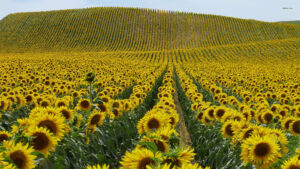
Sunflower production in Ukraine in 2025 will not exceed 13.6-13.7 million tons, which is only 7% higher than in 2024, according to the information and analytical agency APK-Inform.
Analysts noted that weather conditions continue to reduce the yield potential of sunflower in Ukraine, particularly in the south and east of the country, where up to 50% of the total area under this oilseed crop is concentrated. Cool weather in the spring and critically low soil moisture reserves in these regions, combined with insufficient rainfall, have created unfavorable conditions for the development of oilseed crops.
According to their information, a number of farmers report that crops are in very poor condition: uneven plant growth in the field, delayed vegetation, small heads, as a result of which decisions are being made to disc these fields and prepare for winter sowing. In a number of regions, crops suffered from high temperatures in July, and hail was also reported locally.
Experts noted that crop losses in the south and east may be offset by expected better sunflower yields in the center, as well as in the west and north, where temperatures and precipitation were more favorable.
They are convinced that a significant increase in the cost of sunflower seeds in the new season should not be expected.
“First, many factories are changing their operating strategies to avoid losses and negative margins, as in the 2024/2025 season. Second, the low cost of sunflower oil, whose trade slowed in the 2024/2025 season due to lower production. Thirdly, plants will now have an advantage in the form of export duties on soybeans and rapeseed, which may contribute to an increase in the supply of oilseeds on the domestic market,” APK-Inform concluded.